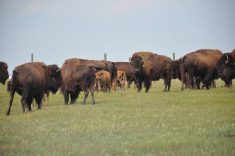DENVER, Colo. – A newly formed producer organization wants to get the U.S. livestock identification program up to speed.
The U.S. Animal Identification Organization is a non-profit group that wants a private, industry-run centralized data collection service for livestock identification, movement and tracking in the event of a disease outbreak. It is meant to cover all livestock, as well as poultry.
“We may not know as producers how this works. The important thing is that it does work,” Charles Miller, a Kentucky beef producer who chairs the new group, said Feb. 2 at a special information session held during the National Cattlemen’s Beef Association convention in Denver.
Read Also

Trump’s tariffs take their toll on U.S. producers
U.S. farmers say Trump’s tariffs have been devastating for growers in that country.
The group has met with the U.S. Department of Agriculture and has been told to proceed with its trials and research. USDA is proposing multiple databases but it has not decided on standards or other details on how an information system might work.
The organization, which includes most of the major livestock species, believes the USDA is not moving quickly enough and may have difficulty achieving a mandatory system.
“This is going to take much longer than they thought initially,” said Rick Stott, a member of a pilot identification and tracking project administered by the Idaho Cattlemen’s Association.
“There isn’t a clear message out there for producers on what needs to be done.”
The ID organization said it is important for the U.S to have a centralized database that is able to report to health authorities about disease outbreaks and animal locations within 48 hours. The group sees such a system as vital to the United States’ ability to compete in the global marketplace and assure domestic consumers that their food is safe.
The USDA set up a National Animal Identification System in 2004 to offer a comprehensive information system for animal disease monitoring, surveillance and eradication programs, working with state and federal animal health officials. It wants premise registrations by April 2007 and an animal movement reporting system by 2009.
Stott’s project involves seven states and Alberta cattle associations and uses an electronic system to track beef and dairy animals within 48 hours. It has 124 participants and 26,000 animals. So far the group has monitored 17, 000 animal movements and 32,700 transactions.
Other members of the ID organization are piloting electronic projects in their regions and want something workable soon for all species.
Lance Kuck of the National Bison Association supports the organization’s efforts, saying there is no good system for bison in the event of a health problem. Meat prices are holding well but if an issue arose, the industry could collapse.
He said part of the problem is the industry is scattered in pockets throughout the country and traceback could be difficult without a national database.
“It would be devastating to the bison industry. We would never come out of it like the beef industry did with BSE.”
Joe Queenan of the animal electronic identification company Viatrace in Dallas, Texas, is working with some of the pilot projects. His company offers a web-based system that comes in 14 languages.
Producers can also use the system for farm management.
“It’s more like a military campaign and things have to run in order,” he said.
Jim Akers of the University of Kentucky said many producers are confused about what is required of them, the cost, how confidential a system may be and how it might work.
He is involved with a pilot project in 10 southeastern states. But at sales time all the enrolled cattle left the region and information was lost.
Regional data collection is meaningless if there is no centralized database to track all animals for disease surveillance, he added.
“We have got to have some overarching ability to do that.”















